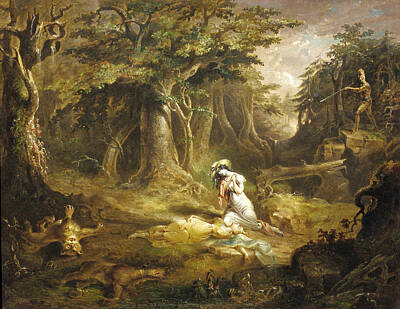John Quidor
The Headless Horseman Pursuing Ichabod Crane
John Quidor (kĬdôr, January 26, 1801 – December 13, 1881) was an American painter of historical and literary subjects. He has about 35 known canvases, most of which are based on Washington Irving's stories about Dutch New York, drawing inspiration from the Hudson Valley and from such English painters as William Hogarth, Isaac Cruikshank, James Gillray, Joseph Wright of Derby, and George Morland.[2]
Biography
Quidor was born in 1801 in Tappan, New York.[1] His family moved to New York City in 1810. In 1818, at the age 17, he began an apprenticeship with John Wesley Jarvis (where artist Henry Inman was also training), which was the only artistic training he received.[1][2][3] The apprenticeship was not a success.[2][3] Quidor felt that Jarvis did not pay sufficient attention to him, favoring Inman over him, leading Quidor in 1822 to sue Jarvis for breach of indenture, winning damages of $251.35.[2] Because he had to admit that he had received inadequate training, the lawsuit damaged his reputation more than Jarvis'.[3]
Following his apprenticeship, Quidor earned a living by painting banners and doing decorative work on steamboats and fire engines for New York's fire companies.[3][4] None of his decorative work is known to have survived.[4] Starting in the mid-1820s, he began creating paintings based on literary themes, including Washington Irving's short stories Legend of Sleepy Hollow and Rip Van Winkle and James Fenimore Cooper's book The Pioneers. During this part of his career, he took on Thomas Bangs Thorpe and Charles Loring Elliott as his apprentices.[2] Of his time working for Quidor, Thorpe recalled that "in all the time we were with Quidor, many months, I do not remember of his giving us anything but easel room and one or two very common engravings to copy. He would absent himself from his studio for days and weeks together. When present, if not painting on a banner or engine back, he would generally lie at full length on the long bench." [3]
A fire destroyed Quidor's studio, located at 46 Canal Street, on December 16, 1835.[3] That incident, combined with two major cholera outbreaks in the area and a financial crash in the late 1830s, led Quidor to abandon New York.[3] He moved to Quincy, Illinois, in 1837,[2][3] and, in 1844, purchased an $8,000 farm, which he paid for by painting eight large religious canvases based on engravings of works by Benjamin West.[2] These canvases were exhibited in New York in 1847, but their whereabouts and status are currently unknown.[2]
In 1851 Quidor returned to New York where he stayed until his retirement in 1869.[2] During this period, his style changed. He simplified his compositions and used a narrower range of colors, which he thinned with varnish so that his stylized, nervously rendered figures nearly disappeared into hazy backgrounds.[2][4] He apparently stopped painting in 1868.[4] He lived in Jersey City, New Jersey, where his eldest daughter lived, from 1869 until his death in 1881.[1][2]
Career
Little appreciated in his time, Quidor died in abject poverty. In 1942, an exhibition of his works at the Brooklyn Museum of Art led to his rediscovery as an important figure in American art.
His paintings establish a mysterious romantic setting for scenes in which he mingled macabre elements with an earthy humor. Many of his works, such as The Headless Horseman Pursuing Ichabod Crane, in the Smithsonian American Art Museum, were inspired by the writings of Washington Irving, who was a personal friend. Irving's A History of New York gave Quidor the subjects for the four paintings in the Brooklyn Museum of Art: Dancing on the Battery (c. 1860), Peter Stuyvesant's Wall Street Gate (1864), Voyage of the Good Oloff up the Hudson (1866), and The Voyage from Communipaw to Hell Gate (1866). These show Quidor's characteristic mellow and harmonious color, poetic imagination, and naïve humor.
Also in the Brooklyn Museum of Art are his three paintings Dorothea, Money Diggers, and Wolfert's Will. He sometimes painted religious subjects, such as Jesus Blessing the Sick.
Further reading
Brooklyn Museum, & Baur, J. I. H. (1942). John Quidor, 1801-1881. [Brooklyn]: Brooklyn Institute of Arts and Sciences. OCLC 4661047
References
"John Quidor". National Museum of American Art. Retrieved August 10, 2012.
Caldwell, John; Rodriguez Roque, Oswaldo (1994). Kathleen Luhrs, ed. American Paintings in the Metropolitan Museum of Art. Volume I: a Catalogue of Works by Artists Born By 1815. Dale T. Johnson, Carrie Rebora, Patricia R. Windels. The Metropolitan Museum of Art in association with Princeton University Press. pp. 479–482.
Roger Panetta, ed. (2009). Dutch New York: the roots of Hudson Valley culture. Hudson River Museum. pp. 223–235. ISBN 978-0-8232-3039-6.
Baur, John I. H. "Quidor, John." Grove Art Online. Oxford Art Online. Oxford University Press. Web..
----
Fine Art Prints | Greeting Cards | Phone Cases | Lifestyle | Face Masks | Men's , Women' Apparel | Home Decor | jigsaw puzzles | Notebooks | Tapestries | ...
----
Artist
A - B - C - D - E - F - G - H - I - J - K - L - M -
N - O - P - Q - R - S - T - U - V - W - X - Y - Z
Retrieved from "http://en.wikipedia.org/"
All text is available under the terms of the GNU Free Documentation License





